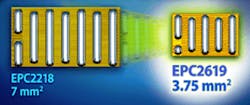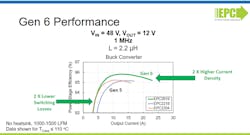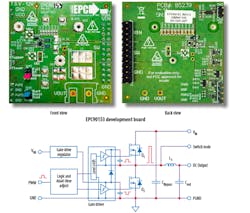Next-Gen Enhancement-Mode GaN Tech Doubles Performance Over Predecessors
When a new power device improves on its predecessor in some parameter by 50% or even 25%, that’s noteworthy. So, when a vendor maintains its latest generation is twice as good, that’s a real attention-getter.
Such a claim is made by Efficient Power Conversion (EPC) for the company’s EPC2619 enhancement-mode gallium-nitride (eGaN) FET, an 80-V, 4-mΩ device. This is the lead product for a new generation of eGaN devices that have double the power density compared to EPC’s prior-generation products. As a “Gen6” device, it’s a factor-of-two smaller than prior Gen5 devices, as well as faster and therefore more efficient.
The EPC2619 has a tiny 1.5- × 2.5-mm footprint, while maximum RDS(on) × area of the EPC2619 (an important figure of merit—FoM—but not the only one) is 15 mΩ-mm2—5X smaller than 80-V silicon MOSFETs (Fig. 1).
Target applications include motor drives such as 28- to 48-V conversion for e-bikes, e-scooters, and power tools; high density dc-dc converters; solar optimizers; and synchronous rectification converting 12 V to 20 V for chargers, adapters, and TV power supplies.
Typical RDS(on) × QOSS, a key FoM that’s indicative of power losses in soft-switching applications, is 87 mΩ-nC, which is 2X better than offered by 80-V silicon MOSFETs. This makes the EPC2619 suitable for soft-switching applications, such as the primary rectification full-bridge for LLC-based DCX dc-dc converters.
Typical RDS(on) × QGD, another important FoM that’s related to power losses in hard-switching applications, is 10X better than with 80-V silicon MOSFETs. This enables switching frequencies that are 10X higher than silicon MOSFETs yet without an efficiency penalty, thus producing the highest power density. Thus, the EPC2619 a good fit for high-frequency hard-switching 24- to 48-V applications, such as used in buck, buck-boost, and boost converters (Fig. 2).
In addition to the six-page EPC2619 datasheet, EPC offers the EPC90153 Development Board ($200, with a 13-page Quick Start Guide) implementing a half-bridge topology designed for 80-V maximum device voltage and 20-A maximum output current. This 2- × 2-in. (50 × 50 mm) board is designed for optimal switching performance and contains all critical components for effective evaluation (Fig. 3).
The EPC2619 is priced at $1.90 each in 2,500-piece volumes. EPC also has an informative seven-page slide presentation “eGaN® Technology Evolution” clarifying the attributes and corresponding benefits of the part and the process technology.



